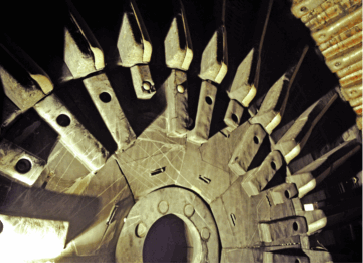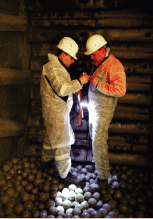Metso mill linings provide longer service life, energy savings, and reduced load on mill bearings and drive

Offering more than 50% of additional durability, Metso’s Poly-Met/metallic combination mill lining has provided excellent wear resistance at a Russian gold mine.
A change in the mill lining type and design in a grinding mill at the Berezitovy gold mine in Russia is bringing significant benefits to the whole comminution process. Metso designed the lining to include rubber and Poly-Met materials on both the feed-end head and discharge system and metallic liners on the shell of the mine’s aging Metso Allis-Chalmers grinding mill.
Metso’s combination lining has resulted in longer service life, energy savings, and a reduced load on the mill bearings and drive.
Metso is the only mill lining supplier that can offer linings made of rubber, Poly-Met, and metal, as well as a combination of these types in the same mill; by selecting the best material for each part, the unique properties of each material can be fully utilized.
“After the first four months of grinding gold ore with Metso mill liners in our SAG mill, the results are very positive. The wear rate is low and, based on the first wear measurement, the expected life is about double compared to what we got from our previous all-metallic liners,” said Nikolay Vershinin, head of the mine’s process plant.
According to Vershinin, instead of changing the liners every four months, the mine now plans to extend the change intervals to six to seven months. This means a great improvement in grinding uptime and mill lining costs. After four months of using the Metso lining, the mill has been in operation for 2,205 hours and production has so far amounted to 488,867 tons of gold ore.
“The Metso combination lining is some 35% lighter compared to full metallic liners, so we now have a much lighter load on the bearings and drive of our old Metso Allis-Chalmers branded grinding mill. The energy consumption has been reduced by 10% as a result of the combination of changes made,” Vershinin said.
“Last, but not least, replacing the Metso rubber and Poly-Met liners is faster and easier than with the previous all-metallic ones. Now, our maintenance crew does not need any special tools for that part of the job,” he added.
An asset of the global Nordgold group, the Berezitovy mine is located in the Russian Far East, in the northern part of the Taiga forest zone, 2,000 km northwest of Vladivostok. The climate is extreme, ranging from -50 C in the wintertime to +35 C in the summer.
Berezitovy exploits an open pit with the benching method, and extracted 1.5 million tons of gold ore in 2013. The average gold content, associated with polymetallic, sulphide-type mineralization, is 2.1 g/metric ton. Silver, zinc and lead are byproducts. Known reserves are sufficient to allow the mining operation to continue for at least eight more years.
The process plant comprises a Russian-made jaw crusher, Metso secondary cone crusher and SAG and ball mills, followed by cyanidation, electrolysis and refinery stages. In 2012, the mine produced 3,617 kg of gold.
After blasting, the gold ore is trucked 1 km to the primary crusher. After being reduced to -300 mm, Metso’s largest gyratory cone crusher, a Nordberg GP500S, handles the secondary crushing.
“We have now crushed more than 1.5 million tons with the GP500S and are very pleased with the results. Our crushing capacity has increased from the previous 250 tons per hour to more than 440. In addition, we now get more fines, which is beneficial for grinding,” said chief mechanic Evgeny Turanov.
Wear mantles for the GP500S are changed after six to seven months, and outside temperatures play a role in service life—during extreme cold conditions, crushing frozen gold ore accelerates the wear.
Located 50 km from the nearest residential area and more than 100 km from the Trans-Siberian railway, by necessity, the Berezitovy mine features a comfortable camp area that includes worker accommodation, catering and recreational facilities. The mine communicates with the outside world via a satellite network. Two teams of 500 workers rotate on a month-on/month-off basis.
This article was written by Eero Hämäläinen and was published in the January 2014 issue of Results: Minerals and Aggregates, Metso’s customer magazine.
WearWin Provides Accurate, Fast Wear Information
Metso monitors grinding mill liner wear in individual mills with intelligent proprietary software called WearWin, and continues to develop easy-to-use tools to reduce mill downtime when physical inspection is necessary.
For accurate wear estimates, Metso recommends that the first inspection be carried out after 25% of the estimated wear life, the second after 50% and the third at 75% of expected wear life. This provides an accurate gauge of the wear rate and indicates reasonable future liner change-out intervals.
 For example, Berezitovy’s SAG mill was stopped at 9 a.m one day for an inspection, and allowing for brief ventilation, two Metso technicians then entered the mill. Wear on the metallic part of the lining was measured using an ultrasonic device, while the remaining thicknesses of the rubber/Poly-Met parts were measured with a special gauge. Measurements were taken at a number of selected positions inside the mill. Generally, each “ring” of the lining is measured with a special focus on areas that display the highest wear.
For example, Berezitovy’s SAG mill was stopped at 9 a.m one day for an inspection, and allowing for brief ventilation, two Metso technicians then entered the mill. Wear on the metallic part of the lining was measured using an ultrasonic device, while the remaining thicknesses of the rubber/Poly-Met parts were measured with a special gauge. Measurements were taken at a number of selected positions inside the mill. Generally, each “ring” of the lining is measured with a special focus on areas that display the highest wear.
The SAG mill was restarted after 10 a.m., and the collected data was sent to Sweden by email, where it was input to the WearWin software. The answer arrived at the mine site at 4 p.m. local time on the same day.
In the Berezitovy case, the results were better than expected—the Poly-Met liners installed at the feed end in January would last longer than estimated and the replacement interval could be extended by a month. And, after wear pattern analysis, the replacement date for the rubber lifter bars, plates and discharge end liners was extended even further.









